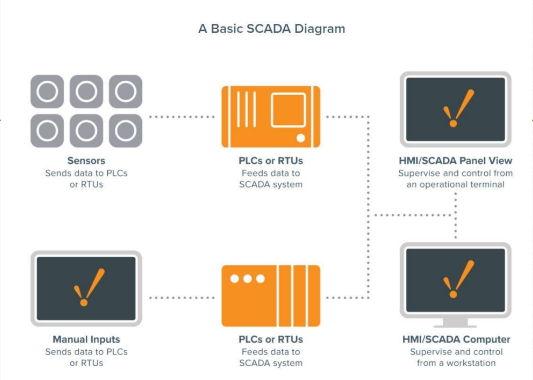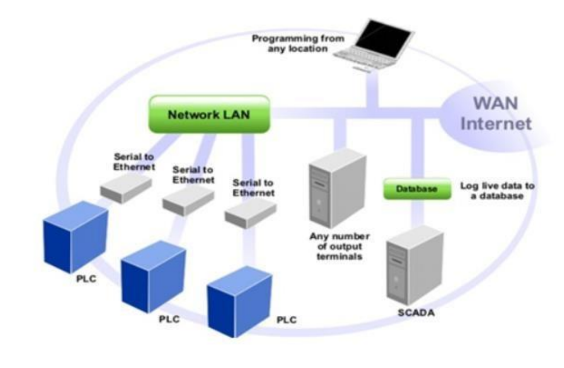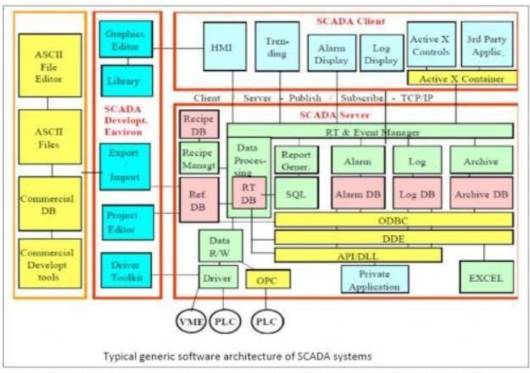lecture 2 scada
1/73
There's no tags or description
Looks like no tags are added yet.
Name | Mastery | Learn | Test | Matching | Spaced |
|---|
No study sessions yet.
74 Terms
SCADA
supervisory control and data acquisition
It is a type of software application program for process control.
SCADA
a central control system which consists of controllers network interfaces, input/output, communication equipment, and software.
SCADA
used to monitor
and control the equipment in the industrial process which includes
manufacturing, production, development, and fabrication.
SCADA systems
The infrastructural
processes include
gas and oil distribution
electrical power
water distribution
Public utilities include
bus traffic system
airport
takes the
reading of the meters and checks the status of sensors in regular intervals so
that it requires minimal interference of humans.
SCADA system
reads the measured flow and level, and send the setpoints to the PLCs
SCADA system
t/f: Before the
concept of SCADA was introduced in the
mid-20th century, many manufacturing
floors, industrial plants, and remote sites
relied on personnel to manually control and
monitor equipment via push buttons and
analog dials.
true
to provide some level of supervisory control
without having to send people to remote locations to interact with each
device, Industrial organizations
started to utilize
relays
timers
In the early ____, computers were first developed and used for industrial
control purposes.
1950s
In the 1960s, _______ was established for monitoring, which allowed for
automated communications to transmit measurements and other data from
remotes sites to monitoring equipment.
telemetry
The term “SCADA” was coined in the
early ____, and the rise of microprocessors and PLCs during that decade
increased enterprises’ ability to monitor and control automated processes
more than ever before.
1970s
Supervisory control and data acquisition (SCADA) is a system of
software and hardware elements that allows industrial organizations to:
Control industrial processes locally or at remote locations.
Monitor, gather, and process real-time data.
Directly interact with devices such as sensors, valves, pumps, motors, and more through human-machine interface (HMI) software.
Record events into a log file.
used to gather data from sensors and
instruments located in remote areas.
SCADA system
gathers the information (like a
leak on a pipeline occurred) and transfers the information back to the system
while giving the alerts that leakage has occurred and displays the information
in a logical and organized fashion.
SCADA system
crucial for industrial
organizations since they help to maintain efficiency, process data for smarter
decisions, and communicate system issues to help mitigate downtime.
SCADA system
a basic SCADA diagram

The SCADA system can be classified into two parts:
client layer
data server layer
layer which caters for the man-machine interaction.
Client layer
layer which handles most of the process data activities.
Data server layer
a centralized system that monitors and
controls the entire area.
SCADA system
t/f: pure software package that is positioned on
top of the hardware.
true
gathers data on the process and
sends the commands control to the process.
supervisory system
RTU.
remote terminal unit
t/f: The SCADA is a remote terminal unit
true
t/f: Most control actions are automatically
performed by RTUs or PLCs.
true
consists of the programmable logic
converter which can be set to specific requirement.
RTU
basic SCADA architecture
programmable logic controllers (PLCs)
remote terminal units (RTUs).
microcomputers that communicate with an array of
objects such as factory machines, HMIs, sensors, and end devices, and then route the
information from those objects to computers with SCADA software.
PLCs and RTUs
processes, distributes, and displays the data, helping operators and other employees analyze
the data and make important decisions.
SCADA software
allows operators to change the set point for the
flow, and enable alarm conditions in case of loss of flow and high
temperature, and the condition is displayed and recorded.
SCADA system
monitors the overall performance of the loop.
SCADA
system
a centralized system to communicate with both wired and wireless
technology to Client devices.
SCADA
system
can run
completely all kinds of the industrial process.
SCADA system controls
refers to the servers and it is composed of a single PC.
SCADA station
communicate with devices in the field through process controllers like
PLCs or RTUs.
data servers
connected to the data servers either directly or via
networks or buses.
PLCs
SCADA system utilizes 2 networks
WAN
LAN
consist of internet protocols used for communication between the master
station and devices.
WAN and LAN
convert the sensor signals to digital data and sends digital data to
the master.
RTUs
Hardware Architecture:

t/f: Most of the servers are used for multitasking and real-time database.
true
responsible for data gathering and handling.
servers
to provide trending, diagnostic data, and manage information
such as scheduled maintenance procedures, logistic information, detailed
schematics for a particular sensor or machine, and expert-system troubleshooting
guides.
software program
t/f: the operator can see a schematic representation of the plant
being controlled.
true
Software Architecture:

SCADA system performs four functions:
Data Acquisitions
Data Communication
Information/Data presentation
Monitoring/Control
These functions are performed by
sensors
RTUs
controller
communication network.
used to collect the important information
sensors
used to send this information to the controller and display the status of the
system.
RTUs
According to the status of the system, the user can give the command
to other system components. This operation is done by the
communication network
consists of thousands
of components and sensors.
The real-time system
It is very
important to know the status of particular
components and sensors.
Data Acquisitions
t/f: The SCADA system uses a wired network to communicate between users
and devices.
true
Sensor and relays are not able to communicate with the
network protocols so ____ used to communicate sensors and net work
interfaces.
RTUs
It connect to sensors in the process, converting sensor signals to digital
data and sending digital data to the supervisory system.
Remote Terminal Units (RTUs)
It is used as field devices because they are more economical,
versatile, flexible, and configurable than special-purpose RTUs.
Programmable Logic Controller (PLCs)
The SCADA system uses the ____________ to provide all of the information gathered from the various sensors.
human-machine interface (HMI)
provides access to multiple
control units which can be PLCs and RTUs.
HMI
provides the graphical
presentation of the system.
HMI
it is an important part of the HMI that is activated
according to the predefined values.
alarm system
t/f: The SCADA system uses different switches to operate each device
and displays the status of the control area.
true
it is implemented to work automatically
without human intervention but in critical situations, it is handled by
manpower.
SCADA system
SCADA systems are the
backbone of many modern industries, including:
energy
food and beverage
manufacturing
oil and gas
power
recycling
transportation
water and waste water
t/f: Effective SCADA systems can result in significant
savings of time and money.
true
scada system applications
Power generation, transmission, and distribution
Water distribution and reservoir system
Public buildings like electrical heating and cooling system.
Generators and turbines and Traffic light control system
scada system advantages
provides onboard mechanical and graphical information
easily expandable. We can add a set of control units ands ensors according to the requirement.
ability to operate critical situations.
allow real-time data from the plant floor to be
accessed from anywhere in the world.
Modern SCADA systems
t/f: Without SCADA software, it would be
extremely difficult if not impossible to gather sufficient data for consistently well-informed decisions.
true
most modern SCADA designer applications have
_______ capabilities that allow users to design
applications relatively easily, even if they don't have extensive knowledge of
software development.
rapid application development (RAD)